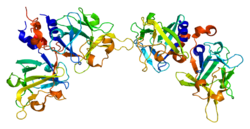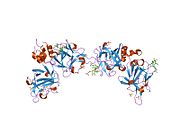Glia-activating factor is a protein that in humans is encoded by the FGF9 gene.
Function
The protein encoded by this gene is a member of the fibroblast growth factor (FGF) family. FGF family members possess broad mitogenic and cell survival activities, and are involved in a variety of biological processes, including embryonic development, cell growth, morphogenesis, tissue repair, tumor growth and invasion. This protein was isolated as a secreted factor that exhibits a growth-stimulating effect on cultured glial cells. In nervous system, this protein is produced mainly by neurons and may be important for glial cell development. Expression of the mouse homolog of this gene was found to be dependent on Sonic hedgehog (Shh) signaling. Mice lacking the homolog gene displayed a male-to-female sex reversal phenotype, which suggested a role in testicular embryogenesis. This gene is involved in the patterning of sex determination, lung development, and skeletal development.
Sex determination
FGF9 has also been shown to play a vital role in male sex development. FGF9’s role in sex determination begins with its expression in the bi-potent gonads for both females and males. Once activated by SOX9, it is responsible for forming a feedforward loop with Sox9, increasing the levels of both genes. It forms a positive feedback loop upregulating SOX9, while simultaneously inactivating the female Wnt4 signaling pathway.
Lung development
In lung development, FGF9 is expressed in the mesothelium and pulmonary epithelium, where its purpose is to retain lung mesenchymal proliferation. Inactivation of FGF9 results in diminished epithelial branching. By the end of gestation, the lungs that are developed cannot sustain life and will result in a prenatal death.
Skeletal development
Another biological role presented by this gene is its involvement in skeletal development and repair. FGF9 and FGF18 both stimulate chondrocyte proliferation. FGF9 heterozygous mutant mice had a compromised bone repair after an injury with less expression of VEGF and VEGFR2 and lower osteoclast recruitment. One disease associated with this gene is multiple synostoses syndrome (SYNS), a rare bone disease that has to do with the fusion of the fingers and toes. A missense mutation in the second exon of the FGF9 gene, the S99N mutation, seems to be the third cause of SYNS. A mutation in Noggin (NOG) and the Growth Differentiation Factor 5 (GDF5) are the other two causes of SYNS. The S99N mutation results in cell signaling irregularities that interfere with chondrogenesis and osteogenesis causing the fusion of the joints during development.
Overexpression of FGF9
FGF9 is a gene within the larger family of fibroblast growth factors (FGF), a type of cell signaling protein. This gene signals embryonic stem cell development and sex determination. FGF9 gene expression is also essential for development of the prostate and maintaining prostate tissue homeostasis. The prostate is a male reproductive organ that is composed of epithelial and stromal cells. Overexpression of FGF9 in prostate epithelial cells can lead to high grade prostate intraepithelial neoplasia, which is a precursor for prostate cancer. Additionally, high expression of the gene in prostate epithelial cells disrupts prostate tissue homeostasis, and promotes a high frequency of metastasis. On the other hand, overexpression of FGF9 in the alternate, prostate stromal cells, promotes the communication with prostate cancer cells.
It has been reported that abnormal expression of FGF9 has oncogenic effects in various human cancers including; ovarian, brain, lung, and colon cancers. In studies with mice, high expression of FGF9 resulted in fusion of the prostate and seminal vesicles, and penis protrusion. More importantly, it caused hyperplasia in both stromal and epithelial compartments. Due to the enlargement of tissue caused by an increase in the reproduction rate of its cells, hyperplasia is frequently the primary stage in the development of cancer.
Although several studies have proven that high expression of FGF9 correlates to the progression of prostate cancer, the question of whether overexpression of FGF9 initiates prostate tumorigenesis is still being tested.
Interactions
FGF9 has been shown to interact with Fibroblast growth factor receptor 3.
References
- Huang, Yanqing (August 2015). Fibroblast Growth Factor Signaling In Prostate Stem Cells And Prostate Cancer. TAMU: Texas A&M University. pp. 1–121.
- ^ GRCh38: Ensembl release 89: ENSG00000102678 – Ensembl, May 2017
- ^ GRCm38: Ensembl release 89: ENSMUSG00000021974 – Ensembl, May 2017
- "Human PubMed Reference:". National Center for Biotechnology Information, U.S. National Library of Medicine.
- "Mouse PubMed Reference:". National Center for Biotechnology Information, U.S. National Library of Medicine.
- Miyamoto M, Naruo K, Seko C, Matsumoto S, Kondo T, Kurokawa T (July 1993). "Molecular cloning of a novel cytokine cDNA encoding the ninth member of the fibroblast growth factor family, which has a unique secretion property". Molecular and Cellular Biology. 13 (7): 4251–9. doi:10.1128/mcb.13.7.4251. PMC 359975. PMID 8321227.
- ^ "Entrez Gene: FGF9 fibroblast growth factor 9 (glia-activating factor)".
- ^ Sánchez L, Chaouiya C (May 2016). "Primary sex determination of placental mammals: a modelling study uncovers dynamical developmental constraints in the formation of Sertoli and granulosa cells". BMC Systems Biology. 10 (1): 37. doi:10.1186/s12918-016-0282-3. PMC 4880855. PMID 27229461.
- Kim Y, Kobayashi A, Sekido R, DiNapoli L, Brennan J, Chaboissier MC, Poulat F, Behringer RR, Lovell-Badge R, Capel B (June 2006). "Fgf9 and Wnt4 act as antagonistic signals to regulate mammalian sex determination". PLOS Biology. 4 (6): e187. doi:10.1371/journal.pbio.0040187. PMC 1463023. PMID 16700629.
- ^ Yin Y, Wang F, Ornitz DM (August 2011). "Mesothelial- and epithelial-derived FGF9 have distinct functions in the regulation of lung development". Development. 138 (15): 3169–77. doi:10.1242/dev.065110. PMC 3188607. PMID 21750028.
- ^ Sivaraj KK, Adams RH (August 2016). "Blood vessel formation and function in bone". Development. 143 (15): 2706–15. doi:10.1242/dev.136861. PMID 27486231.
- "Multiple Synostoses Syndrome". Orphanet. Retrieved 16 April 2017.
- ^ Wu XL, Gu MM, Huang L, Liu XS, Zhang HX, Ding XY, et al. (July 2009). "Multiple synostoses syndrome is due to a missense mutation in exon 2 of FGF9 gene". American Journal of Human Genetics. 85 (1): 53–63. doi:10.1016/j.ajhg.2009.06.007. PMC 2706969. PMID 19589401.
- Santos-Ocampo S, Colvin JS, Chellaiah A, Ornitz DM (January 1996). "Expression and biological activity of mouse fibroblast growth factor-9". The Journal of Biological Chemistry. 271 (3): 1726–31. doi:10.1074/jbc.271.3.1726. PMID 8576175.
- Chellaiah A, Yuan W, Chellaiah M, Ornitz DM (December 1999). "Mapping ligand binding domains in chimeric fibroblast growth factor receptor molecules. Multiple regions determine ligand binding specificity". The Journal of Biological Chemistry. 274 (49): 34785–94. doi:10.1074/jbc.274.49.34785. PMID 10574949.
Further reading
- Naruo K, Seko C, Kuroshima K, Matsutani E, Sasada R, Kondo T, Kurokawa T (February 1993). "Novel secretory heparin-binding factors from human glioma cells (glia-activating factors) involved in glial cell growth. Purification and biological properties". The Journal of Biological Chemistry. 268 (4): 2857–64. doi:10.1016/S0021-9258(18)53852-7. PMID 8428960.
- Mattei MG, Penault-Llorca F, Coulier F, Birnbaum D (October 1995). "The human FGF9 gene maps to chromosomal region 13q11-q12". Genomics. 29 (3): 811–2. doi:10.1006/geno.1995.9926. PMID 8575785.
- Ornitz DM, Xu J, Colvin JS, McEwen DG, MacArthur CA, Coulier F, Gao G, Goldfarb M (June 1996). "Receptor specificity of the fibroblast growth factor family". The Journal of Biological Chemistry. 271 (25): 15292–7. doi:10.1074/jbc.271.25.15292. PMID 8663044.
- Nakamura S, Todo T, Haga S, Aizawa T, Motoi Y, Ueki A, Kurokawa T, Ikeda K (January 1997). "Motor neurons in human and rat spinal cord synthesize fibroblast growth factor-9". Neuroscience Letters. 221 (2–3): 181–4. doi:10.1016/S0304-3940(96)13312-7. PMID 9121694. S2CID 22484813.
- Todo T, Kondo T, Nakamura S, Kirino T, Kurokawa T, Ikeda K (February 1998). "Neuronal localization of fibroblast growth factor-9 immunoreactivity in human and rat brain". Brain Research. 783 (2): 179–87. doi:10.1016/S0006-8993(97)01340-1. PMID 9507114. S2CID 43621705.
- Giri D, Ropiquet F, Ittmann M (July 1999). "FGF9 is an autocrine and paracrine prostatic growth factor expressed by prostatic stromal cells". Journal of Cellular Physiology. 180 (1): 53–60. doi:10.1002/(SICI)1097-4652(199907)180:1<53::AID-JCP6>3.0.CO;2-P. PMID 10362017. S2CID 31704886.
- Klein RD, Maliner-Jongewaard MS, Udayakumar TS, Boyd JL, Nagle RB, Bowden GT (December 1999). "Promatrilysin expression is induced by fibroblast growth factors in the prostatic carcinoma cell line LNCaP but not in normal primary prostate epithelial cells". The Prostate. 41 (4): 215–23. doi:10.1002/(SICI)1097-0045(19991201)41:4<215::AID-PROS1>3.0.CO;2-V. PMID 10544294. S2CID 20541203.
- Plotnikov AN, Eliseenkova AV, Ibrahimi OA, Shriver Z, Sasisekharan R, Lemmon MA, Mohammadi M (February 2001). "Crystal structure of fibroblast growth factor 9 reveals regions implicated in dimerization and autoinhibition". The Journal of Biological Chemistry. 276 (6): 4322–9. doi:10.1074/jbc.M006502200. PMID 11060292.
- Hecht HJ, Adar R, Hofmann B, Bogin O, Weich H, Yayon A (March 2001). "Structure of fibroblast growth factor 9 shows a symmetric dimer with unique receptor- and heparin-binding interfaces". Acta Crystallographica Section D. 57 (Pt 3): 378–84. Bibcode:2001AcCrD..57..378H. doi:10.1107/S0907444900020813. PMID 11223514.
- Tsai SJ, Wu MH, Chen HM, Chuang PC, Wing LY (July 2002). "Fibroblast growth factor-9 is an endometrial stromal growth factor". Endocrinology. 143 (7): 2715–21. doi:10.1210/endo.143.7.8900. PMID 12072406.
- Alizadeh M, Miyamura N, Handa JT, Hjelmeland LM (February 2003). "Human RPE cells express the FGFR2IIIc and FGFR3IIIc splice variants and FGF9 as a potential high affinity ligand". Experimental Eye Research. 76 (2): 249–56. doi:10.1016/S0014-4835(02)00252-X. PMID 12565813.
- Wing LY, Chuang PC, Wu MH, Chen HM, Tsai SJ (November 2003). "Expression and mitogenic effect of fibroblast growth factor-9 in human endometriotic implant is regulated by aberrant production of estrogen". The Journal of Clinical Endocrinology and Metabolism. 88 (11): 5547–54. doi:10.1210/jc.2003-030597. PMID 14602803.
- Popovici C, Conchonaud F, Birnbaum D, Roubin R (September 2004). "Functional phylogeny relates LET-756 to fibroblast growth factor 9". The Journal of Biological Chemistry. 279 (38): 40146–52. doi:10.1074/jbc.M405795200. PMID 15199049.
- Fakhry A, Ratisoontorn C, Vedhachalam C, Salhab I, Koyama E, Leboy P, Pacifici M, Kirschner RE, Nah HD (February 2005). "Effects of FGF-2/-9 in calvarial bone cell cultures: differentiation stage-dependent mitogenic effect, inverse regulation of BMP-2 and noggin, and enhancement of osteogenic potential". Bone. 36 (2): 254–66. doi:10.1016/j.bone.2004.10.003. PMID 15780951.
| PDB gallery | |
|---|---|
| Growth factors | |||||||||
|---|---|---|---|---|---|---|---|---|---|
| Fibroblast |
| ||||||||
| EGF-like domain | |||||||||
| TGFβ pathway | |||||||||
| Insulin/IGF/ Relaxin family |
| ||||||||
| Platelet-derived | |||||||||
| Vascular endothelial | |||||||||
| Other | |||||||||
| Growth factor receptor modulators | |||||||||||
|---|---|---|---|---|---|---|---|---|---|---|---|
| Angiopoietin |
| ||||||||||
| CNTF |
| ||||||||||
| EGF (ErbB) |
| ||||||||||
| FGF |
| ||||||||||
| HGF (c-Met) |
| ||||||||||
| IGF |
| ||||||||||
| LNGF (p75) |
| ||||||||||
| PDGF |
| ||||||||||
| RET (GFL) |
| ||||||||||
| SCF (c-Kit) |
| ||||||||||
| TGFβ |
| ||||||||||
| Trk |
| ||||||||||
| VEGF |
| ||||||||||
| Others |
| ||||||||||







